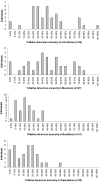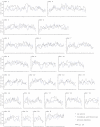A genomewide admixture map for Latino populations
- PMID: 17503322
- PMCID: PMC1867092
- DOI: 10.1086/518313
A genomewide admixture map for Latino populations
Abstract
Admixture mapping is an economical and powerful approach for localizing disease genes in populations of recently mixed ancestry and has proven successful in African Americans. The method holds equal promise for Latinos, who typically inherit a mix of European, Native American, and African ancestry. However, admixture mapping in Latinos has not been practical because of the lack of a map of ancestry-informative markers validated in Native American and other populations. To address this, we screened multiple databases, containing millions of markers, to identify 4,186 markers that were putatively informative for determining the ancestry of chromosomal segments in Latino populations. We experimentally validated each of these markers in at least 232 new Latino, European, Native American, and African samples, and we selected a subset of 1,649 markers to form an admixture map. An advantage of our strategy is that we focused our map on markers distinguishing Native American from other ancestries and restricted it to markers with very similar frequencies in Europeans and Africans, which decreased the number of markers needed and minimized the possibility of false disease associations. We evaluated the effectiveness of our map for localizing disease genes in four Latino populations from both North and South America.
Figures





Similar articles
-
A genomewide admixture mapping panel for Hispanic/Latino populations.Am J Hum Genet. 2007 Jun;80(6):1171-8. doi: 10.1086/518564. Epub 2007 Apr 20. Am J Hum Genet. 2007. PMID: 17503334 Free PMC article.
-
A high-density admixture map for disease gene discovery in african americans.Am J Hum Genet. 2004 May;74(5):1001-13. doi: 10.1086/420856. Epub 2004 Apr 14. Am J Hum Genet. 2004. PMID: 15088270 Free PMC article.
-
Admixture Mapping Identifies an Amerindian Ancestry Locus Associated with Albuminuria in Hispanics in the United States.J Am Soc Nephrol. 2017 Jul;28(7):2211-2220. doi: 10.1681/ASN.2016091010. Epub 2017 Jan 30. J Am Soc Nephrol. 2017. PMID: 28137830 Free PMC article.
-
Overview of Admixture Mapping.Curr Protoc Hum Genet. 2017 Jul 11;94:1.23.1-1.23.8. doi: 10.1002/cphg.44. Curr Protoc Hum Genet. 2017. PMID: 28696560 Review.
-
Prospects for admixture mapping of complex traits.Am J Hum Genet. 2005 Jan;76(1):1-7. doi: 10.1086/426949. Epub 2004 Nov 11. Am J Hum Genet. 2005. PMID: 15540159 Free PMC article. Review.
Cited by
-
Evaluating reported candidate gene associations with polycystic ovary syndrome.Fertil Steril. 2013 May;99(6):1774-8. doi: 10.1016/j.fertnstert.2012.12.033. Epub 2013 Jan 30. Fertil Steril. 2013. PMID: 23375202 Free PMC article. Clinical Trial.
-
Human population admixture in Asia.Genomics Inform. 2012 Sep;10(3):133-44. doi: 10.5808/GI.2012.10.3.133. Epub 2012 Sep 28. Genomics Inform. 2012. PMID: 23166524 Free PMC article.
-
Race, ancestry, and development of food-allergen sensitization in early childhood.Pediatrics. 2011 Oct;128(4):e821-9. doi: 10.1542/peds.2011-0691. Epub 2011 Sep 2. Pediatrics. 2011. PMID: 21890831 Free PMC article.
-
Database mining for selection of SNP markers useful in admixture mapping.BioData Min. 2009 Feb 14;2(1):1. doi: 10.1186/1756-0381-2-1. BioData Min. 2009. PMID: 19216798 Free PMC article.
-
Genetic admixture and obesity: recent perspectives and future applications.Hum Hered. 2013;75(2-4):98-105. doi: 10.1159/000353180. Epub 2013 Sep 27. Hum Hered. 2013. PMID: 24081225 Free PMC article. Review.
References
Web Resources
-
- D.R. Lab Web site, http://genepath.med.harvard.edu/~reich/Software.htm (for ANCESTRYMAP and EIGENSOFT software)
-
- Latino admixture map, http://genepath.med.harvard.edu/~reich/Latinomap.htm (for the list of 1,649 markers)
-
- Online Mendelian Inheritance in Man (OMIM), http://www.ncbi.nlm.nih.gov/Omim/ (for prostate cancer, type 2 diabetes, obesity, gallbladder disease, rheumatoid arthritis, and asthma)
References
Publication types
MeSH terms
Substances
Grants and funding
LinkOut - more resources
Full Text Sources
Medical

